By the end of the nineteenth century scientists had a good picture of what went into and out of a green-plant cell, but they knew little of what was happening inside. Little by little, as their knowledge of chemistry became more sophisticated, their ability to detect what was happening inside the black box increased.
With this knowledge, scientists gradually progressed in understanding to the point of developing reactant/product expressions for what happens in the process of photosynthesis.
During the early 1800s the French chemist Joseph Louis Gay-Lussac began analyzing organic compounds found in plants and animals. He was most interested in compounds that contained just carbon, hydrogen, and oxygen. One compound he analyzed was that formed by plants during photosynthesis.
Gay-Lussac found that the ratio of hydrogen to oxygen in the mystery compound was the same as that of water. This indicated to him that the compound was essentially a combination of carbon and water. For this reason he named the organic compound produced by plants carbohydrate, which means "watered carbon."
What should be added to the reactant/product expression for photosynthesis to include Gay-Lussac's discovery?
Answer: carbohydrate
Gay-Lussac classified several different kinds of sugars as carbohydrates and later found wood to have the same elementary composition as sugar. Thus, the chief substance in wood (cellulose) was added to the organic group called carbohydrates. You studied these in an earlier mini unit.
Subsequently, all starches were found to have the same general chemical composition as sugar and cellulose.
Carbohydrates vary widely in actual molecular organization, but all are composed only of carbon, hydrogen and oxygen. Most carbohydrates can be represented accurately by the general chemical formula (CH2O)n, which shows the ratio of the atoms of their each element but not their actual number. Because the value of n depends upon the particular carbohydrate, you will see carbohydrates in this book represented by the shorter root formula -- CH2O.
Photosynthesis is a process in which atoms of carbon, hydrogen, and oxygen in simple molecules are rearranged to produce an organic molecule of carbohydrate. The process takes place in plant cells which contain chlorophyll and are exposed to incoming light energy. Either of these expressions can represent photosynthesis:
Examine the reactant/product expressions. It should be obvious that the carbon in the carbohydrate comes from CO2.
Look again at the two expressions. Where must the hydrogen in the carbohydrates come from?
Answer: Water (H2O)
There are three possible sources for the oxygen atoms in the carbohydrate. They could come from the carbon dioxide (CO2) or the water (H2O), or both!
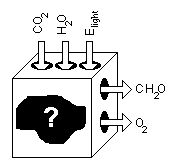 To determine
where the oxygen in the carbohydrate product comes from, we must know more
about what happens inside the closed box of the green-plant cell. How is
it possible to discover the atomic rearrangements which occur when they
cannot be seen?
To determine
where the oxygen in the carbohydrate product comes from, we must know more
about what happens inside the closed box of the green-plant cell. How is
it possible to discover the atomic rearrangements which occur when they
cannot be seen?
In the mid 1900s chemists started using chemical substances called radioactive isotopes. A radioactive isotope is an element which acts just like a normal element in chemical reactions, but it is radioactive. A radioactive element gives off radiation which can easily be detected.
Study the following experiment:
Radioactive oxygen was used to burn hydrogen, and this produced radioactive water (* means the oxygen is radioactive).
A plant was watered with the water containing the radioactive oxygen.
Five hours later the oxygen and the carbohydrates produced by the plant
were checked for radioactivity. Here is the data from the reaction.
| Substance | Radioactive? |
| CH2O | no |
| O2 | yes |
 Click
on the radioactive substances in this closed box:
Click
on the radioactive substances in this closed box:
Examine the illustration. What molecule(s) supply the oxygen for the carbohydrate molecule?
Answer: CO2, (Oxygen in carbohydrates must come from CO2 since neither is radioactive.)
Now you know the sources of each of the three elements which combine during photosynthesis to form carbohydrates.
The water entering the plant contributes its hydrogen to the building of the carbohydrate, and the oxygen is given off as a waste product. This means that the water molecules (click one):- a. are split by a reaction that takes place inside the closed box
- b. remain intact throughout photosynthesis
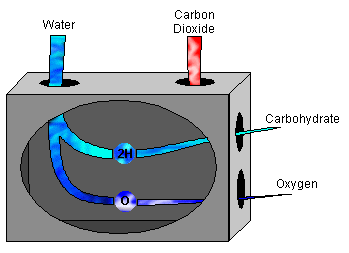 We can
demonstrate the fate of the water molecules during photosynthesis by means
of this illustration.
We can
demonstrate the fate of the water molecules during photosynthesis by means
of this illustration.
The next question, of course, is: How does water split so that its hydrogen can combine with carbon dioxide to form the carbohydrate? In one experiment, dried green leaves were ground up and stirred into water, forming a suspension. All the essential substances for photosynthesis were present-water, carbon dioxide, and chlorophyll. Since this was a test-tube experiment -- not a live situation -- the carbohydrate end product would not be formed.
But in the process of photosynthesis itself, one step is the splitting of the water molecule to yield hydrogen for the carbohydrate end product. When water is split, oxygen is liberated as a by- product of the reaction. To detect this, hemoglobin was added to the suspension in the experiment above. Any oxygen produced by photosynthesis (by the splitting of water) would then combine with the hemoglobin and change its color. If the color change took place, it would indicate that water had been split.
The result of the experiment was this: When the suspension was prepared and allowed to stand, there was no production of oxygen until the suspension was exposed to light. When chlorophyll was omitted from the test tube, again, there was no production of oxygen.
In photosynthesis, the function of light is to promote the splitting of water into hydrogen and oxygen.
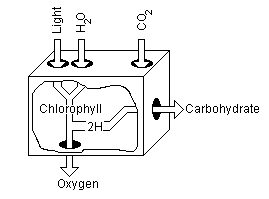
Look at this new illustration of the closed box.
The splitting of water into hydrogen and oxygen in photosynthesis is called photolysis.
We know, then, that part of the process of photosynthesis include photolysis. This suggests that photolysis is one of several steps or stages in the process. Let's look at some experimental data which show that photosynthesis is a multistage process.
The early experiments of Ingenhousz had shown that the rate of photosynthesis varied with the illumination. As the amount of light increased, the rate of photosynthesis (decreased/increased).
It was essentially this same relationship that Blackman began investigating in 1905. He conducted experiments to measure accurately the rate of photosynthesis at ever higher intensities of light. Blackman's plan was to increase the illumination in steps. He would then measure the amount of oxygen produced at each intensity by plants carrying out photosynthesis. Here is a graph representing part of his findings:
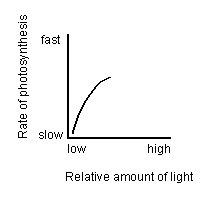
The vertical axis shows the rate of photosynthesis. The horizontal
axis is the relative amount of light illuminating the plants. Near zero
illumination, as the amount of light increases, the rate of photosynthesis
(click one):
- a. also increases
- b. remains unchanged
- c. decreases
But notice that the curve eventually begins to level off. This shows that the rate of photosynthesis is (click one):
- a. increasing more and more rapidly as the amount of light increases
- b. no longer increasing as rapidly with the same increase in the amount of light
- c. going to increase indefinitely as long as the light continues to increase
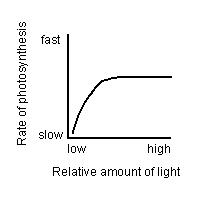
16. Now look at this graph showing all of Blackman's findings.
The curve in this graph becomes completely level after a certain value, demonstrating that beyond a specific point (click one):
- a. any further increase in the amount of light has no effect on the rate of photosynthesis
- b. the light is evidently absorbed more rapidly by the plant, and the rate of photosynthesis increases more rapidly
Now, up to a certain limit, increasing the number of bricks transported to the wall will increase the rate at which the wall goes up. But there is a limit to how much the rate of construction can be accelerated by increasing the speed of the transportation of bricks. That limit is the number of bricks that can be laid in place in a given time. Once this limit is reached, any increase in the number of bricks transported to the wall will (click one):
- a. cause the rate of construction of the wall to increase
- b. cause only a surplus of bricks, and not increase the rate of construction
You know that light energy activates the part of photosynthesis called photolysis. Photolysis is the (click one):
Here is the general equation for photosynthesis that you learned earlier:Think about the fate of the atoms in the reactant water molecule. You can see from the expression that the hydrogen atoms are incorporated into the carbohydrate molecule. The experiments with radioactive oxygen showed that the oxygen in water is (click one):
- a. incorporated into the carbohydrate molecule along with the hydrogen
- b. given off as a by-product and not combined to become part of the
- carbohydrate
Answer: Light or sunlight.
Which of these reactions, then, represents photolysis, the first phase in photosynthesis? (Click one.)
- a. CO2 + H2 + Elight --(chlorophyll)--> CH2O
- b. H2 + O + Elight --(chlorophyll)--> H2O
- c. H2O + Elight --(chlorophyll)--> 2H + O
So we find that photosynthesis is a two-phase process:
Phase 1 = Photolysis: the splitting of water. (Light Reactions
or Light
Dependent)
Phase 2 = C02 fixation: the combination
of carbon dioxide with the hydrogen
released by photolysis. (Dark Reactions or Light Independent)
Write these in your notes.
The illustration shows the relationship between the two phases just examined.
Place this figure in your notes. The next pages will explain each step

This is the end of lesson ten . Click here to go back to the home page and lesson eleven Photosynthesis: Light Reactions. click
Created by the Multimedia
Development Lab, Academic Technology Services.
Last modified October 29, 1997.